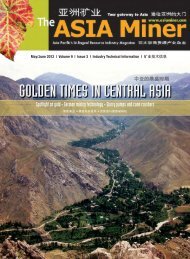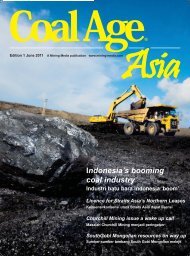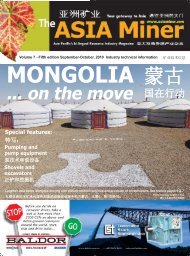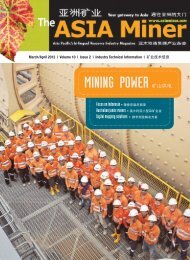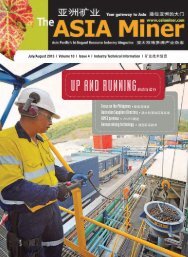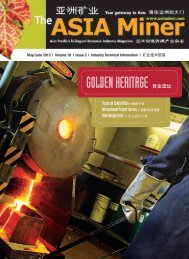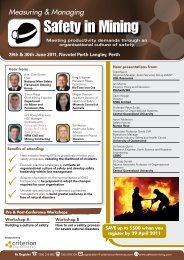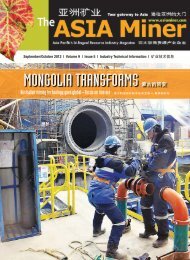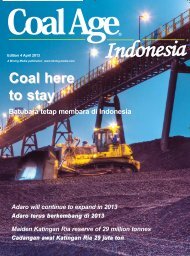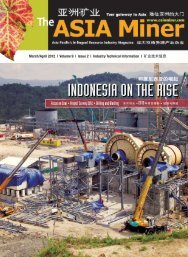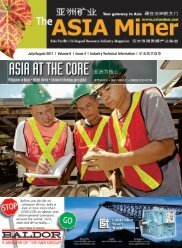MINING WELCOME 欢迎采矿 - The ASIA Miner
MINING WELCOME 欢迎采矿 - The ASIA Miner
MINING WELCOME 欢迎采矿 - The ASIA Miner
You also want an ePaper? Increase the reach of your titles
YUMPU automatically turns print PDFs into web optimized ePapers that Google loves.
From <strong>The</strong> Editor<br />
Precious metals the only store of wealth<br />
SOCIETY needs to realize that the world’s financial problems cannot be<br />
solved by governments printing more paper money and creating more<br />
debt, as has been the case since the link between gold and money was<br />
removed 40 years ago. Gold is the purest form of currency, followed by increasingly<br />
attractive silver, and the gold standard must to be reintroduced.<br />
This was a common theme at the inaugural Gold Symposium in Sydney<br />
during November and remains in the spotlight with the world’s debt crisis<br />
showing no sign of easing as we move into another year. Respected Sydney<br />
gold chartist Alf Field told Symposium delegates that it is more than 40<br />
By John Miller /Editor<br />
years since President Nixon removed the last link between currencies and<br />
gold which launched the era of floating ‘I owe you nothing’ currencies. Money is what any government<br />
deems it to be, generally something it can create in unlimited quantities. This system, along<br />
with the fractional reserve banking system has brought an era of ever increasing debt and credit.<br />
“After August 1971 the US Dollar became the world’s de facto reserve currency, which endowed<br />
the US with the advantage of being able to run current account deficits, buying goods<br />
and services from the rest of the world and paying for them with newly created US Dollars. Nations<br />
in surplus have built up large holdings of US Dollars that they are getting very nervous<br />
about while there is wide recognition that the reserve status of the US Dollar cannot continue.<br />
“<strong>The</strong> distortions that have grown since 1971 have reached proportions that demand change.<br />
<strong>The</strong> problem is that the current generation does not understand that the root cause of the global<br />
financial crisis is unsound money, which can be created at will by governments, combined with<br />
a banking system that has enabled the creation of an unsuitable level of debt.”<br />
Alf Field said, “<strong>The</strong> slate needs to be wiped clean and a new sound monetary system introduced.<br />
This will require elimination of all debt, deficits, unfunded social entitlements, the US Dollar<br />
as reserve currency, and the big one, the $600 trillion of derivatives. To eliminate these<br />
problems by default and deflation will cause a banking collapse and untold economic pain.<br />
“While politicians continue to have the ability to create new money at will, they will do so in<br />
order to prevent a meltdown on their watch. <strong>The</strong> new international monetary system is likely to<br />
involve precious metals. It will have to be money that people trust and that governments cannot<br />
create at will. It is likely that gold will again be the unit of measurement or standard of value<br />
against which the performance of other assets will be judged.<br />
Sprott Asset Management chairman and CEO Eric Sprott told delegates that global financial<br />
markets face meltdown from debt with banks levered at 20:1 and European banks at 30:1.<br />
“With governments buying out troubled banks, the risk is being transferred to the public sector<br />
which is likely to solve it by printing more money and creating more debt.<br />
“Gold production has remained flat for 10 years while demand is increasing rapidly, particularly<br />
in China and other Asian nations. Silver supply is also not keeping up with strong demand<br />
for its use as a precious metal as well as demand for industrial uses.<br />
“<strong>The</strong>re is no doubting gold’s strength as a store of value and it has plenty of upside. Silver is<br />
under-rated and possibly has more potential for increased returns, despite its volatility. <strong>The</strong> supply<br />
ratio of silver to gold is 16:1 but the price ratio is 50:1. If the price ratio was to change to 16:1,<br />
silver prices would be about $100 an ounce.<br />
“Most gold produced throughout history is still around because it has always been a store of<br />
wealth while silver’s strong industrial use and lesser value means most of the silver produced is<br />
not around anymore. This means strong ongoing demand for silver and supply that cannot keep<br />
pace, therefore just like gold, prices must increase.<br />
“Despite the positive outlook for gold as an increasingly valuable store of wealth and the potential<br />
for under-valued gold stocks, gold still only represents 1.5% of all assets.” Eric Sprott<br />
says the market has determined that gold is the ultimate currency and will continue to rise in<br />
value against paper currency while it looks increasingly likely that silver will march towards the<br />
16:1 price ratio, and possibly up to 10:1.<br />
WWW.<strong>ASIA</strong>MINER.COM<br />
<strong>The</strong> <strong>ASIA</strong> <strong>Miner</strong>®<br />
Suite 9, 880 Canterbury Road,<br />
Box Hill, Melbourne,Victoria, 3128 Australia<br />
Phone: +61 3 9899 2981 Mobile: + 61 417 517 863<br />
Editor —John Miller, john@asiaminer.com<br />
Graphic Designer—Christine Hensley, chensley@mining-media.com<br />
Editorial Director—Steve Fiscor, sfiscor@mining-media.com<br />
Europe—Simon Walker, simon.iets@btinternet.com<br />
North America—Russ Carter, russ.carter.emj@gmail.com<br />
Latin America—Oscar Martinez,martin1@ctcinternet.cl<br />
South Africa—Antonio Ruffini,antonior@webafrica.org.za<br />
SALES<br />
Publisher—Lanita Idrus, lanita@asiaminer.com<br />
Vic, NSW, Tas, ACT, PNG, India, Mongolia, China, Central Asia<br />
and Indochina—Rashi Mujoo, rashi@asiaminer.com<br />
WA, NT, SA, Qld, Singapore, Malaysia, Philippines, South Africa, New<br />
Zealand and South Pacific—Orlando Green, orlando@asiaminer.com<br />
North America—Victor Matteucci, vmatteucci@mining-media.com<br />
Latin America—Mauricio Godoy, mgodoy@mining-media.com<br />
Germany, Austria, Switzerland— Gerd Strasmann<br />
strasmannmedia@t-online.de<br />
Rest of Europe—Colm Barry, colm.barry@telia.com<br />
Jeff Draycott, jeff.draycott@WOMPint.com<br />
Japan—Masao Ishiguro, Ishiguro@irm.jp<br />
Indonesia—Dimas Abdillah, dimas@lagunagroup.net<br />
Mining Media International<br />
8751 East Hampden Ave, Suite B-1<br />
Denver, Colorado 80231, U.S.A.<br />
Phone: +1 303-283-0640 Fax: +1 303-283-0641<br />
President—Peter Johnson, pjohnson@mining-media.com<br />
Subscriptions: $120/year—Tanna Holzer,<br />
tholzer@mining-media.com<br />
Accounting—Lorraine Mestas, lmestas@mining-media.com<br />
<strong>The</strong> <strong>ASIA</strong> <strong>Miner</strong>® is published six times per year by Mining Media<br />
International. Every endeavour is made to ensure that the contents<br />
are correct at time of publication. <strong>The</strong> Publisher and Editors do not<br />
endorse the opinions expressed in the magazine. Editorial advice<br />
is non-specific and readers are advised to seek professional advice<br />
for specific issues. Images and written material submitted for<br />
publication are sent at the owners risk and while every care is<br />
taken, <strong>The</strong> <strong>ASIA</strong> <strong>Miner</strong>® does not accept liability for loss or damage.<br />
<strong>The</strong> <strong>ASIA</strong> <strong>Miner</strong>® reserves the right to modify editorial and advertisement<br />
content. <strong>The</strong> contents may not be reproduced in whole<br />
or in part without the written permission of the publisher.<br />
Copyright 2011 Mining Media International Pty Ltd<br />
ISSN: 1832-7966<br />
2 | <strong>ASIA</strong> <strong>Miner</strong> | January/February 2012



